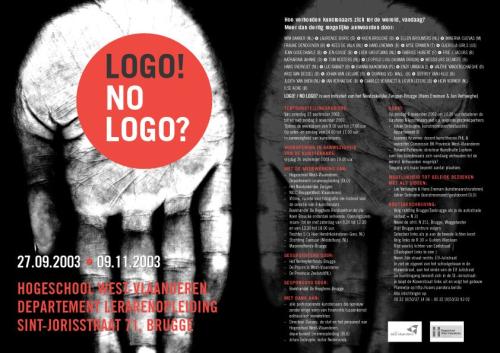Logo! No Logo?
dal 25/9/2003 al 9/11/2003
Segnalato da
25/9/2003
Logo! No Logo?
Hogeschool West Vlaandeeren, Brugge
Actual art in an architectural pearl in the inner city of Brugge, ex-Cultural Capital City of Europe 2002, or how artist work in the 'global' (art)world.

AN EXHIBITION IN THE HOGESCHOOL WEST-VLAANDEREN,
DEPARTEMENT LERARENOPLEIDING (HPI), SINT-JORISSTRAAT, BRUGGE
Actual art in an architectural pearl in the inner city of Brugge, ex-Cultural Capital City of Europe 2002,
or how artist work in the
'global' (art)world
An initiatief of Hans Eneman & Jan Verhaeghe
for the NICC Brugge (West-Vlaanderen)
& Het Noodzakelijke Zwijgen (Brugge)
TO SEE A WORLD IN A GRAIN OF SAND
AND A HEAVEN IN A WILD FLOWER,
HOLD INFINITY IN THE PALM OF YOUR HAND
AND ETERNITY IN A HOUR
WILLIAM BLAKE (1757-1827)
The inspiration of this simple, obvious and clear title is, of course, in the first place, the best-selling book 'NO LOGO' of anti-globalising icon Naomi Klein.
It states that in the actual pan-capitalistic society, all our needs, wishes and desires are generated by images. People (at least the small part of better-off people) are flooded with 'universally known images', all concerning the promise of a beautiful world. At least: as long as we consume the praised products. Products, which are no longer 'products', but are only 'brands'.
The advance of 'brands', 'logo's' and 'images' as marketing strategies started around the 1980's. Publicity was not enough to sell products. Be seen needed a surplus value.
Nike was the trend-setter: You do not only run faster, but you become also a member of the 'JUST DO IT' generation. This marketing strategy is still very successful. This 'brands' are colonising our daily life.
But there was a reaction: not everybody humbly tolerated the supremacy of the 'brands'. Remember the consternation when Shell wanted to sink the 'BRENT SPAR' oil-platform in the ocean. Or the fuss when it became clear the Adidas products were produced by children.
Things went totally wrong when 'brands' were used as radical slogans on gender, race and sexuality. They became standard-bearers of sexual and racial equality. Benneton (UNITED COLORS) was the prototype of how people make consuming luxurious products by a political correct and flashy publicity, designed by life-style philosophers.
In fact this 'agents in meaning' are tributary to the early 'concept art'. Contemporary art and publicity have always had a certain relationship.
Duchamp with his 'Belle Haleine, Eau de Voilette' (1921), for example, and of course 'Pop art' were intensive users of publicity-material.
Departing from the previous meanings we can say that the contemporary artist is searching for a 'LOGO'', an 'image', a 'brand' too: his art must be universally recognisable. The market and the power structures of contemporary arts' narrow bounds want to catalogise simple and fast. Artists who want to be successful should have 'brands' and show those brands as much as possible.
Art in search of such a 'logo' or not, is only one of the themes of this exhibition.
LOGO! NO LOGO can evidently be read literally.
But we can also consider the large world-map which is painted on the playground of the high school (were the exhibition runs), and is been seen from almost everywhere in the building. It is a work of Jef Geys and it are the remains from a previous exhibition.
Annex to that is the motto of the exhibition: To see a world..., excerpt from a poem of William Blake.
And so on: 'Logo! No Logo?'.
Hogeschool West Vlaandeeren
Departement Lerarenopleiding
Sint-Joristraat 71, Brugge



